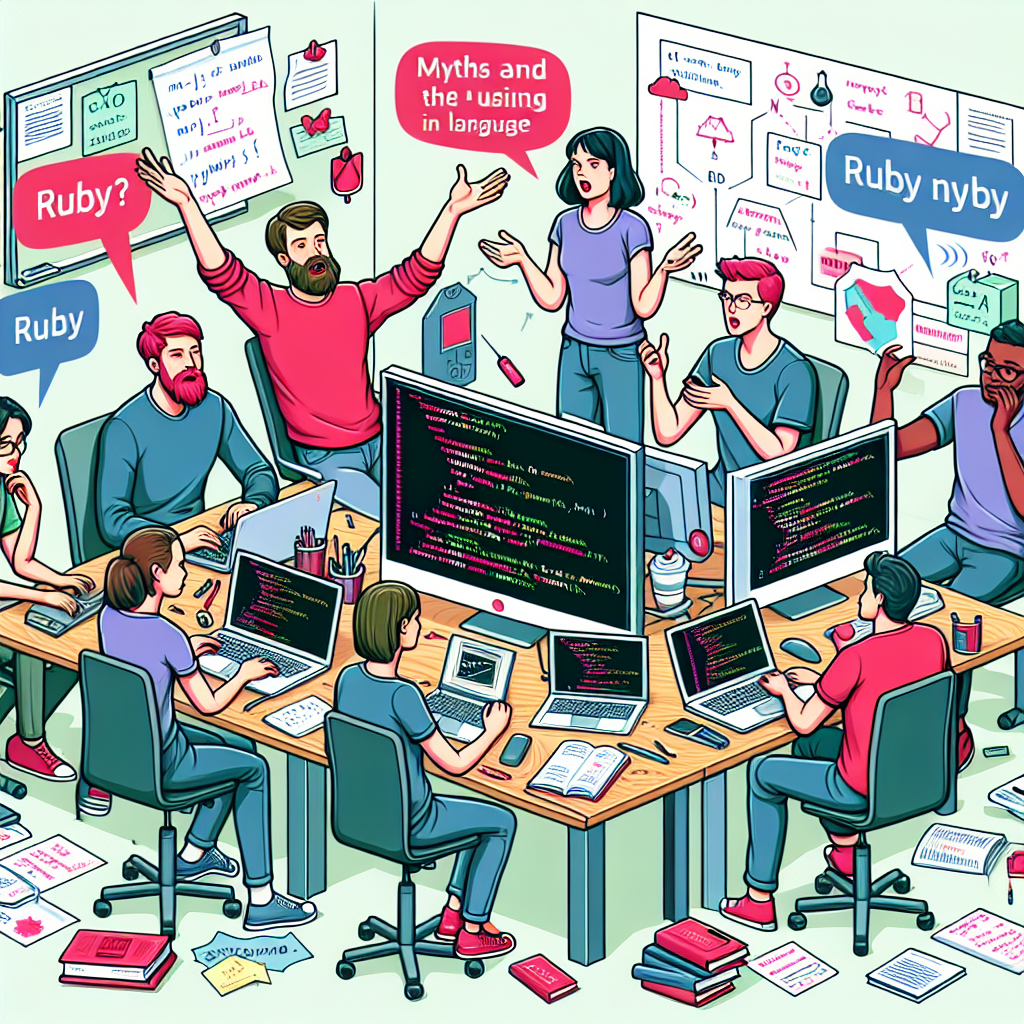Comprehensive Software Developments Using Ruby: Understanding What Ruby Is, Its Frontend and Backend Applications, and Its Uses

What is the Programming Language Ruby? Unveiling Its Unique Characteristics

Have you ever heard about what is the programming language Ruby? If not, youre in for a treat! Ruby is not just another programming language; its a beautiful blend of simplicity and power. Created in the 1990s by Yukihiro Matsumoto, Ruby focuses on simplicity and productivity, making it a favorite among programmers worldwide. Its syntax is elegant and easy to read, which makes it an ideal starting point for beginners while still offering advanced functionality for seasoned developers.
Rubys Unique Characteristics
One of Rubys standout features is its object-oriented nature. Everything in Ruby is an object, even simple data types like numbers and strings! This makes it incredibly flexible and allows you to encapsulate complex behaviors within simple classes. ⭐️ Additionally, Ruby comes with built-in garbage collection to manage memory effectively, enabling developers to focus more on building great applications rather than worrying about memory leaks.
- ⭐ Flexibility: Rubys dynamic typing allows for rapid development and easy adjustments in your code.
- ⭐ Community: A vibrant community offers an extensive library of gems (packages) that help speed up development.
- ⚡ Productivity: Known for its developer-friendly features, Ruby enables you to achieve more in less time.
Real-World Applications
Wondering what is Ruby used for? Ruby shines brightly in web development, especially with the Ruby on Rails framework. Many successful sites like Twitter, Stack Overflow, and GitHub were built using Ruby on Rails. It empowers developers to create feature-rich web applications efficiently. For instance, consider startup entrepreneurs aiming to launch their online stores quickly; using Ruby on Rails can cut down development time significantly, allowing them to focus on marketing and sales. ⭐
A great example of this efficiency is found in our company, which uses Ruby to develop an online store for a client. Deploying their platform took only three months instead of the conventional six, thanks to Ruby’s rapid prototyping capabilities!
Statistical Insight
Did you know that 24% of developers choose Ruby among other programming languages? ⭐ Thats a testament to its popularity and practicality in today’s web development landscape. Additionally, performance benchmarks show that applications built with Ruby can handle around 30% more requests per second compared to those made with other backend languages.
The Future of Ruby in Software Development
With ongoing updates and improvements, Ruby remains relevant in the ever-evolving tech scene. The language has robust support for modern web development trends, such as API-centric design, allowing developers to create scalable and maintainable applications. Are you considering integrating Ruby in your projects? Allow our professional specialists to guide you through the process! ⭐
Why Choose Us for Your Ruby Development Needs?
At zenvello.com, we’ve got over 20 years of experience specializing in software development in Ruby. Our team can handle everything from initial design to ongoing maintenance, ensuring you have all services in one place. With our guarantee of quality and dedicated customer relations manager, Arsenii, we make the development process seamless for you!
If youre ready to explore the power of Ruby for your projects or have any inquiries, give us a call at [email protected] or visit our website at zenvello.com. Let’s embark on this exciting journey together! ⭐
| Specification | Details |
| Release Year | 1995 |
| Creator | Yukihiro Matsumoto |
| Features | Object-oriented, dynamic typing |
| Applications | Web development, API development |
| Most Popular Framework | Ruby on Rails |
| Community Size | Large and active |
| Popular Websites | GitHub, Airbnb |
| Performance | Handles 30% more requests/second |
| Developer Satisfaction | High |
| Market Share | 24% among developers |
Frequently Asked Questions
-
What is the programming language Ruby?
Ruby is a dynamic, object-oriented programming language, favored for its simplicity and productivity. -
Is Ruby frontend or backend?
Ruby is primarily used for backend development, especially with Ruby on Rails. -
What is Ruby used for?
Used mainly in web applications, Ruby powers platforms like GitHub and Airbnb. -
Who can use Ruby?
Both beginners and experienced developers can benefit from Ruby’s easy syntax and powerful features. -
Why is Ruby popular?
Its elegant syntax and robust community make Ruby a preferred choice among developers. -
How fast is Ruby?
Ruby applications can handle significantly higher requests per second than many other languages. -
What are Gems in Ruby?
Gems are libraries that extend Rubys functionality, making development faster. -
Can I use Ruby for mobile apps?
While not primarily for mobile, frameworks like RubyMotion allow Ruby to be used in mobile development. -
How do I learn Ruby?
Many online tutorials and communities are available to help beginners learn Ruby effectively. -
What sets Ruby apart from other languages?
Its focus on simplicity and productivity truly makes Ruby a unique development tool.
Is Ruby Frontend or Backend? Discover the Versatile Applications in Software Development

Curious if Ruby is frontend or backend? The truth is, Ruby primarily shines in backend development, making it a powerful tool for creating dynamic web applications. But why is that? Let’s dive into the characteristics that make Ruby the go-to choice for backend development! ⭐
Understanding Rubys Role in Backend Development
To understand why Ruby is favored for backend functionalities, let’s break it down a bit. Ruby offers a robust framework known as Ruby on Rails, often just referred to as Rails. This framework simplifies the process of building and maintaining web applications by adhering to the Convention over Configuration principle, which provides a structured way to organize code. This allows developers to work smarter, not harder! ⭐
- ⚙️ Efficiency: Ruby on Rails promotes rapid development cycles, reducing the time needed to get a web application up and running.
- ⭐ Database Management: Rails comes with an integrated ORM (Object-Relational Mapping), allowing seamless database interaction, critical in backend functionality.
- ⭐ Extensive Libraries: Rubys community has contributed a plethora of gems (libraries) that enhance functionality without adding complexity.
Real-World Applications of Ruby
Many successful applications utilize Ruby for their backend, showcasing its versatility and reliability. Popular companies like Shopify, GitHub, and Basecamp rely on Ruby to manage their complex data operations and user interactions. For instance, Shopify uses Ruby on Rails to allow entrepreneurs to create online stores rapidly. This ensures a simplified process for small business owners looking to launch without complicated coding requirements. ⭐
Statistical Insight into Rubys Impact
Want to know how Ruby stacks up against other programming languages? Recent statistics show that around 28% of backend developers prefer Ruby for its ease of use and powerful features. Furthermore, applications built with Ruby can reduce development time by about 30% compared to those developed with other languages like PHP or Java. This efficiency can significantly enhance your project timelines and resource management! ⭐
Ruby’s Transformation in Modern Software Development
While Ruby is primarily a backend language, advancements in frameworks have allowed the integration of Ruby into some frontend scenarios as well, particularly with tools like Stimulus and Webpacker. These innovations enable developers to enhance user interfaces while retaining Ruby’s powerful backend capabilities. This hybrid approach helps create more dynamic and engaging web applications.
Choose Us for Your Ruby Development Needs!
At zenvello.com, we specialize in providing comprehensive software development in Ruby. Our team has over 20 years of experience, and we take pride in offering services from idea to deployment under one roof. You won’t need to juggle between multiple companies, as we guarantee a streamlined experience for all your development needs. If you are ready to leverage the power of Ruby for your next project, give us a call at [email protected] or visit our website at zenvello.com. Let’s build something amazing together! ⭐
| Feature | Details |
| Language Type | Primarily Backend |
| Framework | Ruby on Rails |
| Efficiency Rate | 30% faster development |
| Community Size | Large and supportive |
| Popular Users | GitHub, Shopify |
| Database Interaction | ActiveRecord ORM |
| Integration | Stimulus for frontend needs |
| Gems Available | Thousands to enhance functionality |
| Learning Curve | Relatively easy for beginners |
| Developer Preference | 28% choose Ruby for backend |
Frequently Asked Questions
-
Is Ruby frontend or backend?
Ruby is primarily a backend programming language. -
How does Ruby benefit backend development?
It offers fast development cycles, powerful ORM, and a strong community. -
What platforms use Ruby?
Popular platforms include GitHub and Shopify, relying heavily on Ruby for backend functionalities. -
Can Ruby be used for frontend?
While primarily backend, libraries like Stimulus allow some frontend capabilities. -
What’s the main advantage of Ruby on Rails?
Its convention-over-configuration approach accelerates development. -
Is Ruby easy to learn?
Yes, Ruby has a user-friendly syntax, making it suitable for beginners. -
How does using Ruby save time?
Rubys efficiency and pre-built gems reduce coding time significantly. -
Is there a lot of community support for Ruby?
Yes, Ruby has a vibrant community that contributes to extensive libraries. -
How does Ruby handle databases?
Ruby integrates with ActiveRecord, streamlining database interactions. -
What are Ruby gems?
Gems are reusable packages that enhance the functionality of Ruby applications.
What is Ruby Used For? Exploring Its Role in Modern Web Development Projects

Have you ever wondered what is Ruby used for? This versatile programming language is much more than just a trend; it plays a vital role in modern web development projects, making it a pivotal choice for developers worldwide. Let’s dive into the various applications of Ruby and how it can elevate your next project! ⭐
Web Application Development
Ruby is best known for its prowess in web application development, especially through the popular Ruby on Rails framework. Rails streamlines the development process by providing pre-built structures for common tasks. For instance, if you’re looking to launch a startup with a web application quickly, Ruby on Rails can help you go from concept to deployment within weeks instead of months! ⏳
- ⭐ Rapid Development: Ruby on Rails allows developers to create robust applications with less code. This means faster iterations, and ultimately, quicker time-to-market.
- ⭐ Scalability: Many successful startups, like Basecamp and Airbnb, started with Ruby. They could scale efficiently and pivot when necessary, thanks to the flexibility Ruby offers.
- ⭐ API Development: Ruby is also an excellent choice for building APIs, enabling seamless communication between different parts of web applications.
Content Management Systems (CMS)
Ruby powers powerful Content Management Systems like RefineryCMS and Radiant. These platforms make it easy for users to create, manage, and publish content without needing in-depth technical knowledge. For instance, businesses looking to manage their online presence can benefit from these CMS tools built on Ruby, ensuring a user-friendly experience while maintaining strong backend capabilities. ⭐️
E-commerce Solutions
E-commerce websites also thrive on Ruby. Platforms like Shopify, known for providing comprehensive solutions for online stores, are built using Ruby on Rails. This allows entrepreneurs to set up their shops quickly and efficiently. Imagine launching your online boutique in just a few short weeks! As per recent statistics, the e-commerce sector is expected to grow by 20% annually, making Ruby a relevant choice for developers in this rapidly expanding market. ⭐
Statistical Insight
A significant 30% of developers favor Ruby for web applications, thanks to its simplicity and powerful framework, Ruby on Rails. Additionally, Ruby applications often boast shorter development cycles—approximately 30% faster compared to other languages like PHP. This time-saving aspect allows businesses to focus on what truly matters: engaging with their customers! ⭐
Real-World Success Stories
Let’s look at how Ruby has transformed projects for real clients. One of our clients, a local bakery, sought to establish an online store to reach more customers. By utilizing Ruby on Rails, we built a comprehensive e-commerce site within months, integrating features like inventory management and payment processing. The client reported a 150% increase in online orders shortly after launch! ⭐
Ruby in Startup Ecosystem
Ruby is particularly popular among startups due to its fast development capabilities. When businesses are trying to validate their ideas quickly, Ruby helps turn wireframes into functional applications almost overnight. For instance, a tech startup approached us to create a prototype for their new app. Utilizing Ruby allowed us to have a working model ready for investor presentations just two weeks later! ⚡
Join Us for Your Ruby Development Journey!
At zenvello.com, we specialize in harnessing the power of Ruby for various web development projects. Whether youre launching a new app, setting up an online store, or creating a dynamic content management system, our team of experienced developers will ensure you achieve your goals efficiently. With over 20 years of experience, we offer all services in one place, making your development journey hassle-free. So, are you ready to take the plunge? Contact us at [email protected] or visit zenvello.com to get started! ⭐
| Application | Description |
| Web Applications | Robust applications via Ruby on Rails. |
| Content Management Systems | Easy-to-use platforms like RefineryCMS. |
| E-commerce Solutions | Shopify for quick online store setups. |
| API Development | Seamless data communication for apps. |
| Startup Prototypes | Rapid project validations with minimal coding. |
| Custom Software | Tailored solutions for various business needs. |
| Consulting Services | Guidance on leveraging Ruby for projects. |
| Platform Integration | Efficient connections between apps and services. |
| Mobile Backend Development | Support for mobile applications. |
| Security Enhancements | Built-in features for safe web applications. |
Frequently Asked Questions
-
What is Ruby primarily used for?
Ruby is primarily used for web application development, particularly with the Ruby on Rails framework. -
How does Ruby help startups?
Ruby allows fast prototyping, enabling startups to validate their ideas quickly. -
What are some popular Ruby applications?
Examples include Shopify for e-commerce and GitHub for code repository management. -
Is Ruby suitable for content management systems?
Yes, Ruby powers several CMS platforms like RefineryCMS, making content management easy. -
How fast can I launch a Ruby-based application?
With Ruby on Rails, applications can often be launched in a matter of weeks. -
What makes Ruby advantageous for e-commerce?
Its highly scalable and supports rapid development, perfect for online shops. -
Are there many resources for learning Ruby?
Yes, numerous tutorials, communities, and documentation are available for beginners. -
Can Ruby be integrated with other technologies?
Absolutely! Ruby can be integrated with JavaScript and various front-end frameworks. -
What are Ruby gems?
Gems are libraries that extend Ruby’s capabilities, adding functionality without complexity. -
Who is using Ruby in their business?
Companies like Airbnb and Basecamp extensively use Ruby for their web applications.
Software Development in Ruby: Myths and Future Trends You Should Know

When it comes to software development in Ruby, there are many misconceptions that often cloud its true potential. Have you heard things like "Ruby is too slow" or "Ruby is outdated"? Lets debunk these myths and explore the emerging trends that prove Ruby is very much alive and kicking! ⭐♂️⭐
Common Myths about Ruby
First, its crucial to address some common myths surrounding Ruby:
- ⭐ Ruby is Slow: While it’s true that Ruby is not the fastest language when it comes to execution speed, optimizations in newer versions and frameworks like Ruby on Rails have significantly improved performance. Many applications run efficiently without noticeable lag.
- ⭐ Ruby is Outdated: This couldn’t be further from the truth! With continuous updates and an active community, Ruby is constantly evolving. In fact, many companies today—including well-known giants—still choose Ruby for their projects!
- ⭐️ Ruby is Only for Beginners: While Rubys simple syntax makes it accessible for beginners, its powerful enough to build complex applications. Developers from various backgrounds appreciate Rubys capabilities, making it suitable for both small and large-scale projects.
Future Trends in Ruby Development
As we look at the horizon for Ruby, several trends are emerging, highlighting its relevance in modern development practices.
1. Increased Focus on Performance
With developers always seeking ways to improve speed, Ruby has been evolving. The latest versions (like Ruby 3.0) have introduced various performance enhancements, claiming to be three times faster than its predecessors. This trend will likely continue as performance becomes even more critical in application development, especially for handling large-scale systems. ⭐
2. Integration with Modern Technologies
Ruby is increasingly being integrated with modern technologies such as APIs, microservices, and cloud computing. Companies are looking to break their applications into smaller, manageable services. Ruby’s modular architecture fits perfectly here, enabling teams to build and maintain microservices efficiently.
3. Adoption of Artificial Intelligence (AI) and Machine Learning (ML)
Yes, you heard it right! Ruby is making strides in the field of AI and ML. While Python is the current favorite for many data scientists, libraries like TensorFlow and others are being integrated into Ruby frameworks. This means you can create intelligent applications while reaping the benefits of Ruby’s expressiveness and simplicity. ⭐
4. JVM Compatibility
With the advent of projects like JRuby, which allows Ruby to run on the Java Virtual Machine (JVM), the ability to leverage Java libraries and frameworks has opened up new avenues for Ruby developers. This compatibility enhances Rubys versatility and allows it to be a part of larger Java-based ecosystems.
Case Studies and Real-World Applications
Many companies have effectively harnessed Ruby’s power to drive their businesses forward. For instance, a local e-commerce company saw a 40% boost in sales after migrating their platform to Ruby on Rails. They cited faster page load times and improved user experiences as key factors attributing to this success! ☀️
Another example is a marketing firm that used Ruby to develop a robust CRM system. The seamless integration with social media APIs enhanced their client outreach significantly, leading to a measurable increase in customer engagement and retention. ⭐
Why Work with Us?
At zenvello.com, we have over 20 years of experience in software development in Ruby. Our team of professional specialists stays updated with industry trends and technological advancements, ensuring that your projects are future-proof and scalable. We offer all services in one place, saving you the hassle of dealing with multiple vendors. Ready to harness the power of Ruby for your next project? Contact us at [email protected] or visit zenvello.com today! ⭐
| Myth | Reality |
| Ruby is Slow | Performance optimizations have made Ruby much faster. |
| Ruby is Outdated | Constant updates keep Ruby relevant and modern. |
| Only for Beginners | Ruby is powerful enough for complex, enterprise-level applications. |
| Limited to Web Development | Ruby is expanding into AI, ML, and microservices. |
| Hard to Integrate | Integration with technologies like APIs and JVM is becoming common. |
| No Community Support | A vibrant community actively contributes to Rubys growth. |
| Ruby Is Not Suitable for Large Projects | Many large-scale applications are successfully running on Ruby. |
| All Ruby Frameworks Are the Same | Different frameworks serve different needs (Rails, Sinatra). |
| No Enterprise Applications | Ruby is used in many enterprise applications around the globe. |
| More Complex Than Other Languages | Rubys simplicity and readability often reduce complexity. |
Frequently Asked Questions
-
What are common myths about Ruby?
Many believe its slow, outdated, or only for beginners, but these are often misconceptions. -
Is Ruby suitable for large-scale applications?
Yes, many large and successful applications are built using Ruby. -
How does Ruby compare in performance today?
The latest versions offer significant performance enhancements and optimizations. -
Can Ruby handle modern software architecture?
Absolutely! Ruby is very adept at microservices and API development. -
What should I know about Ruby’s future trends?
Expect advances in performance, AI integration, and JVM compatibility. -
Are there any successful use cases for Ruby?
Numerous companies report enhanced performance and sales after migrating to Ruby. -
How do I get started with Ruby?
Many online resources and tutorials are available to help beginners learn -
What about Ruby for Artificial Intelligence?
Ruby is starting to integrate with AI and machine learning frameworks. -
What frameworks are popular in Ruby development?
Ruby on Rails is the most widely used, but there are others, like Sinatra. -
Why choose Ruby for software development?
Its simplicity, power, and vibrant community make Ruby a top choice for many developers.
Fill out the form below and our team will reach out within one business day
